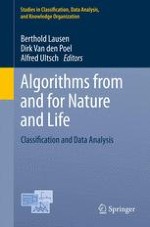2013 | OriginalPaper | Chapter
Modified Randomized Modularity Clustering: Adapting the Resolution Limit
Authors : Andreas Geyer-Schulz, Michael Ovelgönne, Martin Stein
Published in: Algorithms from and for Nature and Life
Publisher: Springer International Publishing
Activate our intelligent search to find suitable subject content or patents.
Select sections of text to find matching patents with Artificial Intelligence. powered by
Select sections of text to find additional relevant content using AI-assisted search. powered by
